Healthy ice cream: Which brands are best?
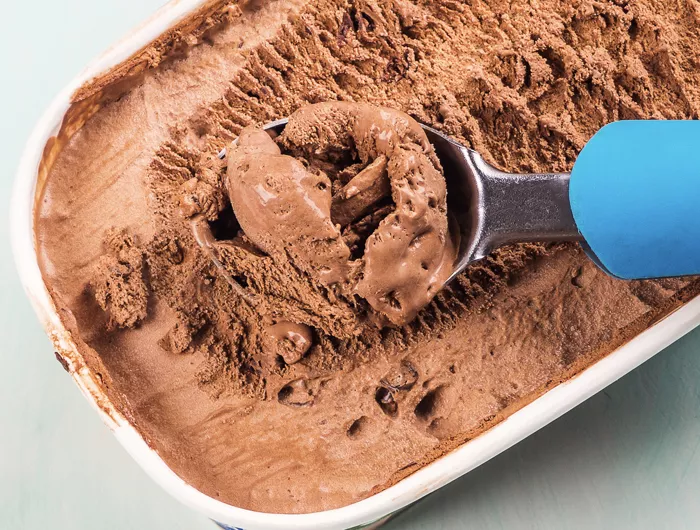
tenkende - stock.adobe.com.
It’s clear that ice cream isn’t a health food. Even a lower-sugar ice cream is unlikely to be as nutritious as healthy foods like whole fruit or yogurt. But some supermarket brands do far less damage than others. Our “Better Bite” picks don’t pile on the added sugar, saturated fat, and empty calories like a pint of Ben & Jerry’s or Häagen-Dazs does. If you’re looking for a better-for-you frozen dessert, here’s what to consider.
This article comes from Nutrition Action. We don’t accept any paid advertising or corporate or government donations. Any products we recommend have been vetted by our staff and are not advertisements by the manufacturers. They’re just healthier foods we think you’d like to know about!
What to look for in a healthier ice cream
Our chart ranks popular brands from least to most saturated fat and added sugar. Limiting both helps keep heart-harming fat in check and reduces “empty” calories (that means calories from foods low in nutrients). For every 2/3-cup serving, the “Better Bites” picks in our chart have:
No more than 4 grams of saturated fat. That’s 20 percent of the 20-gram daily max (Daily Value) for adults. You’ll find those lower sat-fat levels mostly in light and reduced-fat ice creams, which beat the 10 to 18 grams in super-premium ice creams like Ben & Jerry’s and Häagen-Dazs by a mile.
No more than 16 grams of added sugar. That’s equal to four teaspoons, and it’s not low. (It’s one-third of a day’s 50-gram max.) But up to 16 grams is realistic for ice creams that aren’t sweetened with low-calorie sweeteners like stevia extract, allulose, or monk fruit extract, which aren’t for everyone’s taste buds. At least that much added sugar is also typical for plant-based ice creams, which don’t get any sweetness from lactose, the naturally occurring sugar in dairy milk. And a 16-gram cutoff for added sugar still beats super-premium ice creams, which can go twice that high.
No calorie limit. Calories matter, but we kept things simple. It wasn’t necessary to set a calorie limit because the ice creams that met our saturated fat and added sugar limits already had far fewer calories than higher-fat, higher-sugar ice creams.
No acesulfame potassium, sucralose, food dyes, or titanium dioxide. The first two are low-calorie sweeteners often used in low-sugar or no-sugar-added ice creams. “Food dyes” means ingredients with a color and a number, like the Blue 1 and Yellow 5 in some brands’ mint chip ice creams. Titanium dioxide isn’t a dye, but it lends a white color to foods. (It shows up in Halo Top Mix-Ins Sweet Cream Cold Brew, probably because the ice cream is swirled with white “sweet cream flavored ribbons.”)
Our Chemical Cuisine guide rates all four of those additives as “avoid.” That’s because of their links to cancer risk (acesulfame potassium and sucralose), neurobehavioral impacts in some kids (food dyes), or DNA damage (titanium dioxide).
How much ice cream is in a serving?
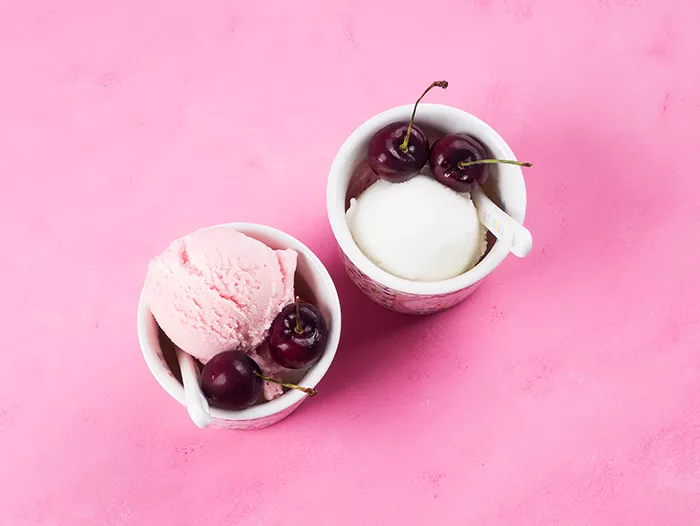
Our “What to look for in a healthier ice cream” limits are based on a 2/3-cup serving, the FDA’s standard serving size used on Nutrition Facts labels. How does 2/3 cup compare to your serving of ice cream?
The only way to tell is to measure it out. Most measuring-cup sets come with a 1/3 cup measure but not a 2/3 cup measure, so you’ll need to measure twice.
But if you have an inexpensive kitchen scale—the kind that precisely weighs flour, sugar, etc., for baking—you’re in luck. Nutrition Facts labels for ice creams list the weight of a serving in grams. For example, “Serving size 2/3 cup (90g),” says Breyers Mint Chocolate Chip. That means you can dish out 90 grams of it instead of measuring 2/3 cup. Gram weights for different brands and flavors vary, so check your label.
Tip: To put portioning on autopilot, serve your ice cream in a mini bowl or small dish (“ramekin”) instead of a cereal-size bowl. Want to add volume? Toss in a handful of fresh or defrosted fruit like strawberries, dark sweet cherries, or sliced banana.
Are Halo Top and other lower-sugar ice creams worth it?
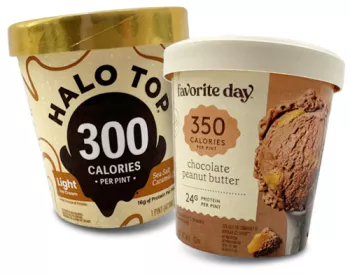
“When Halo Top first found its way into grocery store freezers, it became the first of its kind and created an entirely new category in ice cream,” boasts the company’s website.
Indeed. Since the launch of Halo Top over a decade ago, other lower-sugar, higher-protein (and higher-priced) pints of light ice cream have followed its lead. And that means more ice creams that meet our “Better Bite” criteria. But before you dig into a whole pint at one sitting—as the “calories per pint” emblazoned on the front suggests—consider the pros and cons.
Added sugar and sweeteners
Halo Top and many of its competitors—like newcomer Protein Pints and the Halo-lookalike “reduced fat” pints from Target’s Favorite Day brand—slash added sugar to new lows. Most flavors have no more than a mere 5 grams (about 1 teaspoon), a fraction of the 3 teaspoons or so in longstanding light ice creams like Edy’s or Dreyer’s Slow Churned. (Halo Top’s new, more sugary “Mix-Ins” line is on par with Slow Churned.)
Another big plus: Halo-type ice creams largely shun the low-calorie sweeteners we rate as “avoid”—like the sucralose and acesulfame potassium in Breyers CarbSmart—in favor of safer stevia or monk fruit extracts.
Halo Top and Favorite Day pints also contain the sugar alcohol erythritol. A 2023 study found a link between blood levels of erythritol and heart attacks and strokes, but the evidence that eating erythritol raises your risk is far from solid (more on that here). Prefer to avoid or limit foods with erythritol until we know more? Click here to see a list of which ice creams in this article have it…or stick to an occasional serving of Halo Top, not the whole pint at once.
GI effects
Halo Top and similar brands need to lean on ingredients that help replace the taste, volume, and texture you’d get from fat and sugar. Without those ingredients, lower-fat, lower-sugar ice creams tend to freeze harder and be less creamy and more icy. Unfortunately, some replacements can spell trouble for sensitive GI tracts.
For example, replacing sugar often means adding processed fibers like inulin (chicory root), polydextrose, and soluble corn fiber or sweeteners like allulose, which is a poorly digested low-calorie form of sugar. Those sugar replacers are safe to eat, but people who are sensitive to them can experience GI side effects like gas or bloating if they eat too much. Even Edy’s and Dreyer’s Slow Churned—traditional “light” ice creams that cut fat and calories but have more sugar than Halo Top—add polydextrose and soluble corn fiber to many flavors.
Lower-fat, lower-sugar ice creams also tend to rely on emulsifiers to improve their texture. And researchers are studying whether emulsifiers like cellulose gum (in Halo Top and many other ultra-processed foods) affect gut health. So far, cellulose gum has been linked to inflammation and disruption of the intestinal lining in mice and among a handful of people in one small human study, so the jury’s still out. And those findings don’t mean that all emulsifiers—like the safe lecithin in some ice creams, for example—are suspect.
The bottom line: Don’t confuse Halo Top with health food. Save it for an occasional lower-sugar treat. And if ice creams with inulin, soluble corn fiber, polydextrose, or allulose give you GI distress, steer clear.
Taste
Some people detect an aftertaste from the low-calorie sweeteners like stevia or monk fruit extract that are in sugar-slashed ice creams. If that’s you, don’t settle. Instead, try a traditional light ice cream (like one of the Better Bites from Edy’s or Dreyer’s Slow Churned) or a regular ice cream that’s modest in saturated fat and sugar (like one of our Better Bites from Breyers).
Protein

“Good source of protein,” says the front of the Halo Top Peanut Butter Cup container. “18g of protein per pint.”
Halo Top has a reputation for protein, but per serving, it only has about 6 grams. That’s twice as much as you’d expect from regular ice cream, but it’s not high. You’d get about 12 grams from a low-fat refrigerated Greek yogurt for the same calories.
We found one ice cream with considerably more protein than Halo Top: newcomer Protein Pints, which packs 10 grams of protein in a 120-to-160-calorie serving. Two flavors (Chocolate and Strawberry) go light enough on their whole milk and cream ingredients to stay within our Better Bite sat fat boundary.
How do the Protein Pints add extra protein without boosting calories? They subtract some sugar calories. With help from monk fruit extract plus 10 to 12 grams of allulose per serving, they limit the added sugar (and its calories) to a mere 1 to 3 grams. If that’s enough allulose to upset your GI tract, leave Protein Pints on the shelf. No GI troubles? Enjoy it.
The bottom line: Think of a protein boost from your ice cream as a nice bonus. But if—like most U.S. adults—you’re already getting enough protein, low-protein ice cream isn’t a dealbreaker.
Price
Halo Top and its lookalikes cost about three times as much as regular ice cream. A petite pint of Halo Top (3 servings) and a 1½-quart tub of Edy’s, Dreyer’s, or Breyers (9 servings) each sells for around $5 to $7.
Regular ice cream: From Better Bites to Ben & Jerry’s
If you don’t love the taste, texture, ingredients, or price of Halo Top, don’t fret. A few big brands (and, often, similar store brands) make light ice creams that are lower in fat and calories than regular ice cream without any low-calorie sweeteners:
Edy’s or Dreyer’s Slow Churned Light Ice Cream
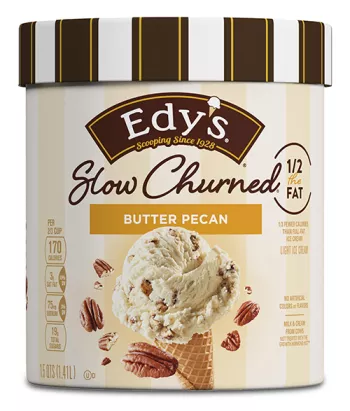
All but one of its dozen flavors are Better Bites (food dyes disqualify Mint Chocolate Chip). A 2/3-cup serving has no more than 130 to 170 calories, 1.5 to 3 grams of saturated fat, and 11 to 15 grams of added sugar. Not bad! But if you’re sensitive to the GI effects of some processed fibers, check the ingredient list: About half the flavors add soluble corn fiber and polydextrose.
Breyers Better Bites
Breyers has no “light” line, but 8 flavors are low enough in saturated fat and added sugar to meet our “Better Bite” limits (see our chart). They’re also made without low-calorie sweeteners or processed fibers, so they’re a good alternative if your taste buds or GI tract don’t tolerate Halo Top and its lookalikes. And even flavors that just miss a Better Bite with 5 or 6 grams of sat fat per serving are a big improvement over super-premiums like Ben & Jerry’s or Häagen-Dazs, with their 10 to 18 grams per serving.
What’s the best lactose-free ice cream?
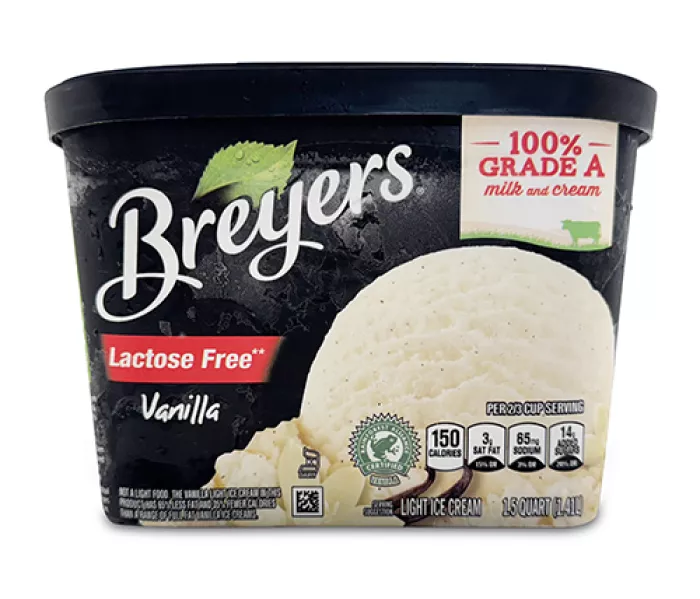
Lactose intolerant? All plant-based ice creams are dairy-free, so they’re also free of lactose (milk sugar). But if you want dairy’s taste and texture, look for ice creams that add lactase enzyme to break down their lactose into more easily digestible sugars.
It’s a pity they’re so hard to find. Lactaid offers the largest array of flavors, but they’re all full-fat ice creams with 7 or 8 grams of sat fat per serving. The only Better Bite we found: Breyers Lactose Free Vanilla. To jazz it up, try add-ins like crushed cookies, chopped fruit, toasted pecans, or a sprinkle of mini chocolate chips.
Is plant-based ice cream healthier?

The good news for plant-based eaters: The taste and texture of dairy-free ice creams just keep getting better. We’re talking about the rich, dense mouthfeel of new oat-milk-based Ben & Jerry’s Non-Dairy, the oh-so-silky So Delicious Cashewmilk varieties, and the velvety texture of Oatly. They all give full-fat dairy ice cream a run for its money. Alas, they also rack up similar totals: around 40 percent to 50 percent of a day’s sat fat and added sugar per serving.
What gives? While refrigerated liquid oatmilk or cashewmilk is typically made with heart-healthy unsaturated oils like sunflower or canola, the ice creams also contain saturated-fat-rich coconut oil.
But a handful of Better Bites—So Delicious Creamy Vanilla Soymilk and most flavors of Cado—break that mold. True to its name, Cado uses avocado purée and/or avocado oil, so it’s higher in healthy fat and lower in saturated fat.
Frönen makes a fuss about sweetening its flavors with only coconut sugar and/or honey, yet neither is any healthier than regular cane sugar. To its credit, the company uses less of those sweeteners (12 to 15 grams of added sugar) than many plant-based brands. But Frönen’s varieties also have enough coconut cream (their first ingredient) to hit 9 to 15 grams of sat fat. That’s about 50 to 75 percent of a day’s max.
Is sorbet healthy?
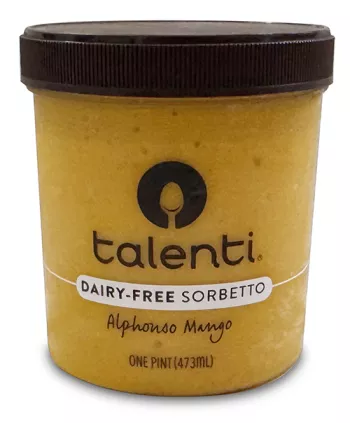
Most fruit sorbets aren’t even within striking distance of a Better Bite. Surprised? Saturated fat isn’t the issue (they’ve got no dairy, which means no dairy fat). It’s sugar, alas.
Take Häagen-Dazs. A 2/3-cup serving of its Mango Sorbet adds 40 grams of sugar—as much as a 12 oz. can of sugary Coke. Then there’s the Passion Fruit & Sweet Pear, with enough added sugar (50 grams) to hit the daily recommended maximum. That’s 12 teaspoons. Sheesh!
Talenti Alphonso Mango (26 grams of added sugar in 2/3 cup) is an improvement. But you can do better. Try downsizing to a half cup. That will shave off 6 grams of sugar and get you closer to our 16-gram limit for a Better Bite. Its intense, sweet-tart flavor means you might be satisfied with less. (Or pretend you’re in a restaurant, where dessert portions of sorbets are often modest.) Garnish with your own berries to fill out your serving dish.
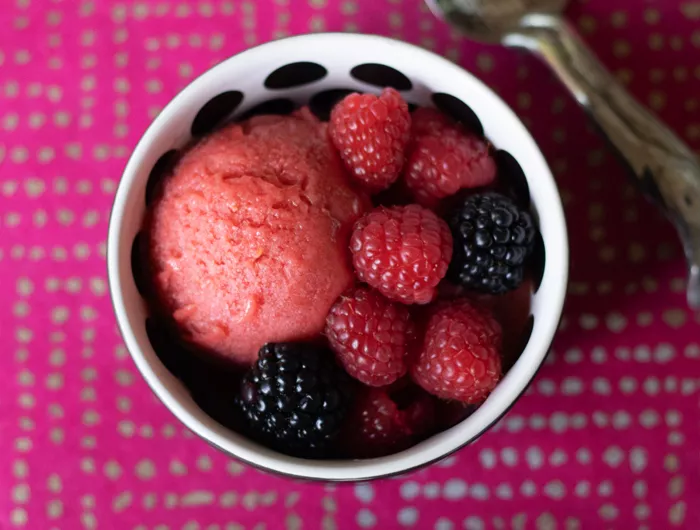
Of course, no supermarket container can hold a candle to The Healthy Cook’s new recipe for Raspberry Mango Sorbet. If you’ve got the three ingredients (raspberries, mango, bananas) and a few hours to let the freezer do its job, you’ve got smooth, creamy, sweet-tart sorbet on the way. You won’t need any added sugar. Enjoy!
Our chart comparing healthier ice creams and other brands
A 2/3-cup serving of our Better Bites has no more than 4 grams of saturated fat and 16 grams of added sugar. We disqualified products (marked with a •) made with one or more of the risky additives acesulfame potassium, food dyes, sucralose, or titanium dioxide. (Click here for a list of which additives each of those products contains.) Ice creams and gelatos are ranked from least to most saturated fat, then added sugar. Sorbets are ranked from least to most added sugar.
Support CSPI today
As a nonprofit organization that takes no donations from industry or government, CSPI relies on the support of donors to continue our work in securing a safe, nutritious, and transparent food system. Every donation—no matter how small—helps CSPI continue improving food access, removing harmful additives, strengthening food safety, conducting and reviewing research, and reforming food labeling.
Please support CSPI today, and consider contributing monthly. Thank you.

The latest
Our best (free) healthy tips
Our free Healthy Tips newsletter offers a peek at what Nutrition Action subscribers get—scrupulously researched advice about food of all kinds, staying healthy with diet and exercise, and more.

